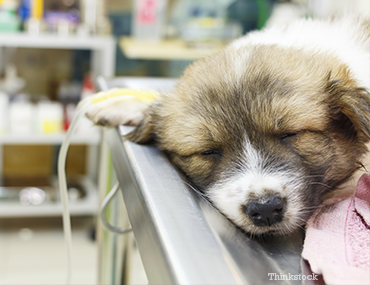
Dr. Phil Zeltzman is a traveling, board-certified surgeon in Allentown, PA. His website is www.DrPhilZeltzman.com. He is the co-author of “Walk a Hound, Lose a Pound” (www.WalkaHound.com).
Chris Longenecker, a Certified Veterinary Technician in Reading, PA, contributed to this article.
You may not realize it, but you’ve probably heard of Minimally Invasive Surgery. You may even have experienced it. Do you know somebody who has had:
- Arthroscopic surgery of the knee?
- Laparoscopic removal of the gallbladder?
- A colonoscopy?
These are all examples Minimally Invasive Surgery (MIS) which can be just as important for dogs and cats.
Minimally Invasive Surgery instruments
There are basically two types of “scopes” (fiber optic tubes that can be inserted in various body parts) used for Minimally Invasive Surgery: There are flexible scopes, which allow you to go from the mouth into the stomach or from the anus into the colon. And then there are rigid scopes, which are used for procedures in the joints (arthroscopy), the belly (laparoscopy) or the chest (thoracoscopy).
All scopes have a camera at the end, which enables the doctor to perform various procedures including observation, biopsies, and surgery.
 Arthroscopy (Minimally Invasive Surgery of the joints)
Arthroscopy (Minimally Invasive Surgery of the joints)
Virtually any joint can be observed with arthroscopy. The most common joint involved is the knee, often to confirm a torn ACL (Anterior Cruciate Ligament) in hazy cases.
Other arthroscopic situations include removing a bone chip—in dogs with elbow dysplasia for example.
In some cases, surgery can be performed with the scope only. Other times, we don’t have a choice and the joint has to be opened completely to perform the procedure. Either way, arthroscopy can be a great help to specific patients.
Laparoscopy (Minimally Invasive Surgery of the belly)
Laparoscopy enables observation of organs in the belly and facilitates taking biopsies. The surgeon can take samples of the liver, kidney or even intestine. In some cases, tumors or organs can be removed with the help of the laparoscope.
A prophylactic gastropexy, designed to attach the stomach and prevent it from twisting (i.e., bloat), can be performed either with an open-belly procedure, or with laparoscopy.
Some vets even spay dogs with a laparoscope.
Thoracoscopy (Minimally Invasive Surgery of the Chest)
Thoracoscopy, or scoping the chest, allows for observing organs, taking biopsies and removing masses. A good use of thoracoscopy is to treat pericardial effusion, a condition where the sac (pericardium) around the heart fills up with fluid or blood, putting severe pressure on the heart. Treatment involves removing part of the sac, either with open chest surgery or thoracoscopy.
Why is Minimally Invasive Surgery right for my dog or cat?
These three procedures are less invasive than a traditional surgical approach. They cause less trauma to the patient and sometimes allow for a quicker recovery time. The surgeon makes one-three small incisions in the skin, about the size of a pen: one for the scope, and one or two for special instruments. Think of it as performing surgery through one or several key holes--it requires some serious skills.
The surgery is performed “looking through the camera" or more commonly, looking at a TV screen—which makes organs appear much bigger; therefore, small problems that would be difficult to see with the naked eye during an “open” procedure, become more visible.
The main drawback of Minimally Invasive Surgery is that the equipment is sophisticated and expensive, which means that MIS surgery will often cost more than traditional. Therefore, few family practices offer Minimally Invasive Surgery. If your pet needs such a procedure, you may be referred to a specialist.
If you have any questions or concerns, you should always visit or call your veterinarian -- they are your best resource to ensure the health and well-being of your pets.
